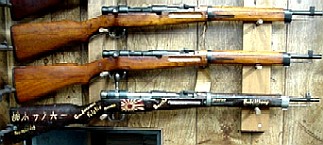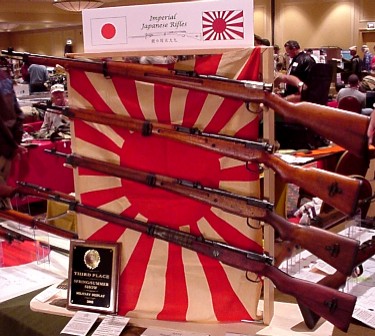 What is a Japanese Rifle? - Modern Japanese rifles were produced in various configurations and calibers at several Arsenals located thoughout Japan, China, and Korea from about 1897 through 1945.
What is a Japanese Rifle? - Modern Japanese rifles were produced in various configurations and calibers at several Arsenals located thoughout Japan, China, and Korea from about 1897 through 1945.What is the 'Flower' on the receiver? - The 'Flower' on the receiver is a 16 petalled 'Chrysanthemum.' It is considered a symbol of the royal family, and was placed on Military Rifles to indicate ownership by the Emporer. The Chrysanthemum was often removed, (by grinding or otherwise defaced,) to prevent a possession of the Emporer from falling into the hands of the 'Barbarians'.
What is a Chrysanthemum? - The 16 petalled 'Chrysanthemum' is considered a symbol or 'Mon' of the royal family, and was placed on Military Rifles to indicate ownership by the Emporer. The Chrysanthemum was
 often removed, (by grinding or otherwise defaced,) to prevent a possession of the Emporer from falling into the hands of the 'Barbarians'.
often removed, (by grinding or otherwise defaced,) to prevent a possession of the Emporer from falling into the hands of the 'Barbarians'.What is a 'Mon' - mon \Mon\, n. [Jap.] (Japan) The badge of a family, esp. of a family of the ancient feudal nobility. The most frequent form of the mon is circular, and it commonly consists of conventionalized forms from nature, flowers, birds, insects, the lightnings, the waves of the sea, or of geometrical symbolic figures; color is only a secondary character. It appears on lacquer and pottery,
 and embroidered on, or woven in, fabrics. The imperial chrysanthemum, the mon of the reigning family, is used as a national emblem. Formerly the mon of the shoguns of the Tokugawa family was so used.
Source: Webster's Revised Unabridged Dictionary, © 1996, 1998 MICRA, Inc.
and embroidered on, or woven in, fabrics. The imperial chrysanthemum, the mon of the reigning family, is used as a national emblem. Formerly the mon of the shoguns of the Tokugawa family was so used.
Source: Webster's Revised Unabridged Dictionary, © 1996, 1998 MICRA, Inc. Why is the 'Flower'/Chrysanthemum ground? - The Chrysanthemum was often removed, (by grinding or otherwise defaced,) to prevent a possession of the Emporer from falling into the hands of the 'Barbarians'.
Why is the butt stock 'split'? - The Japanese used two smaller pieces of wood to make the stocks. They found they could get more effective use of the raw materials by using a two-piece dove-tailed design on the buttstock.
Why do some call them "Model 38s or 99s" and some call them "Type 38s or 99s"? - This is a question left to the scholars, initially the symbol on the receiver known as "Shiki" was thought to designate "Type", in recent years it has been proposed that the "Shiki" mark actually denotes "Model", loosely the terms are interchangeable, but some feel "Model 38 or 99" is historically and linguistically more correct than "Type 38 or 99". Old habits die hard, you will mainly see both or just the numeric designation on this site to prevent controversy
What kind of rifle do I have? - Please refer to the Model/Type page, holding the mouse pointer over a receiver type will display the translation. What is my rifle worth? - Without knowing exactly what condition, model, and completeness, its hard to tell. Generally the more common Japanese Rifles run from $50 to about $350. When referring to Type/Model 14 Nambu pistols, what does STG or LTG mean? - Its just a contraction for the terms; Small Trigger Guard, or Large Trigger Guard. It describes the shape of the trigger guard